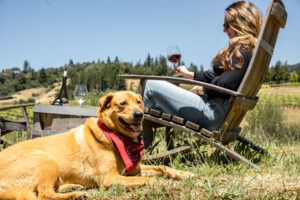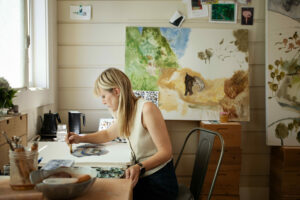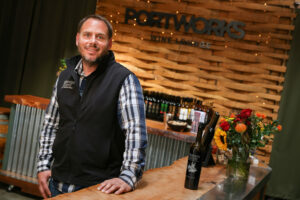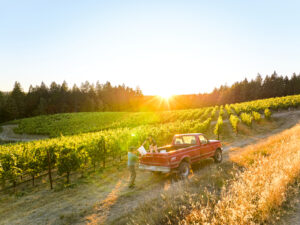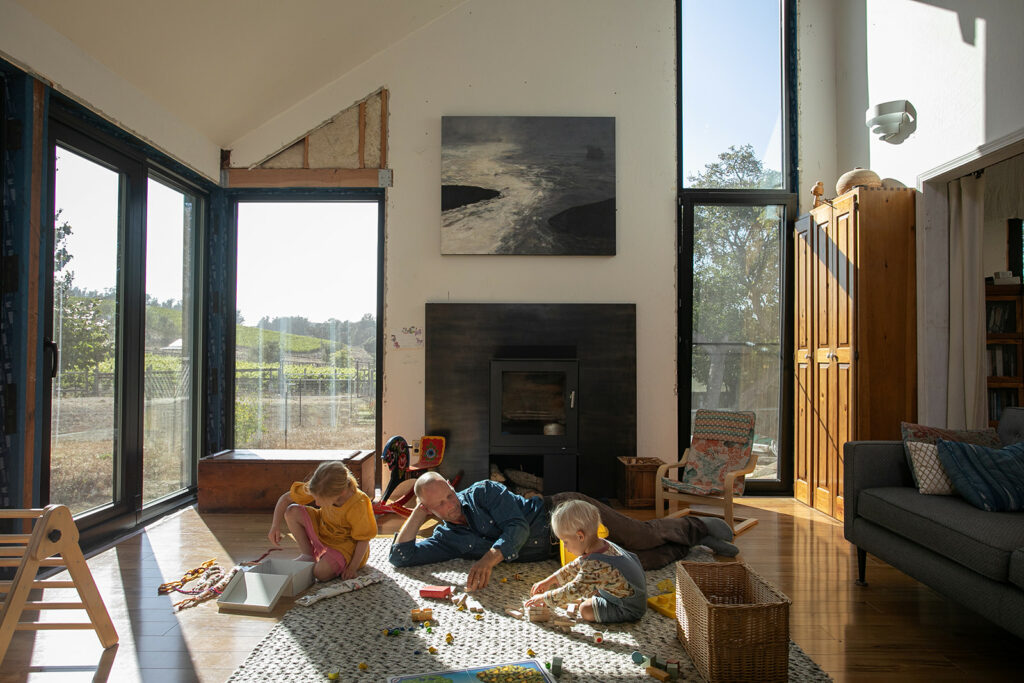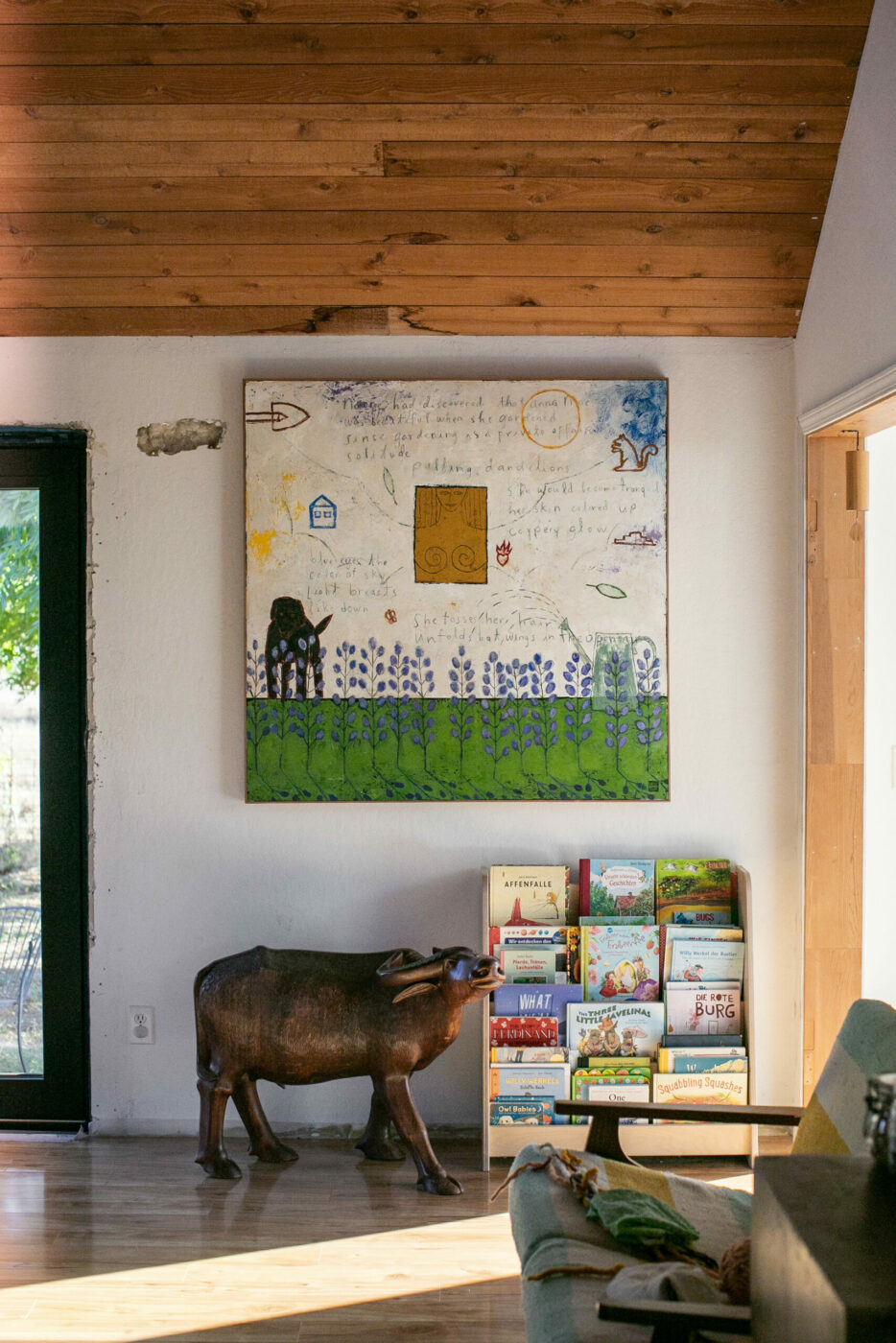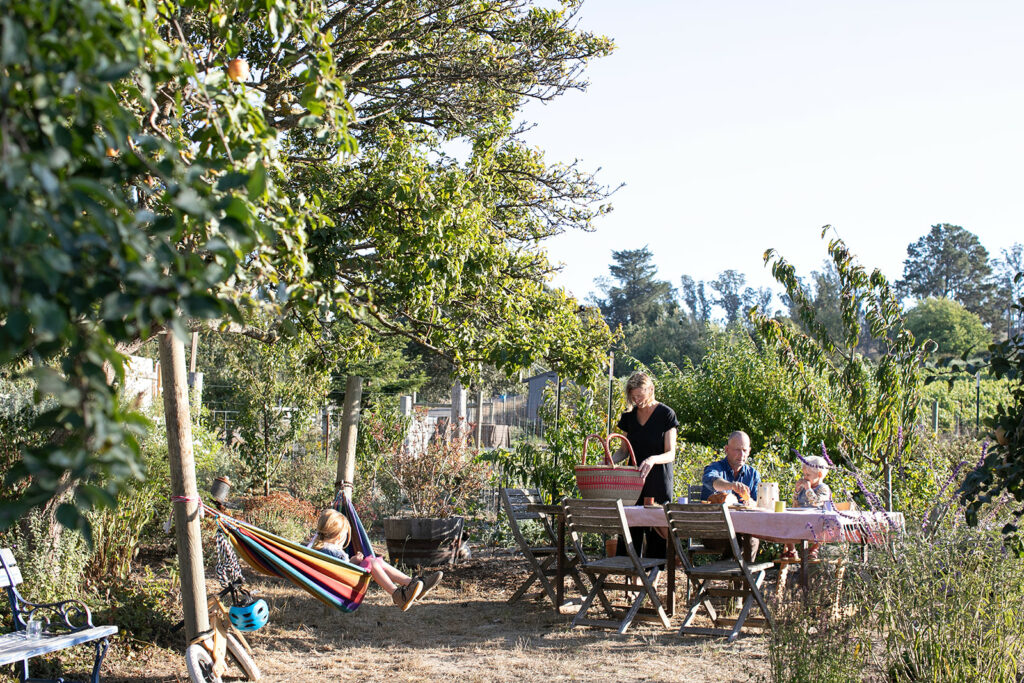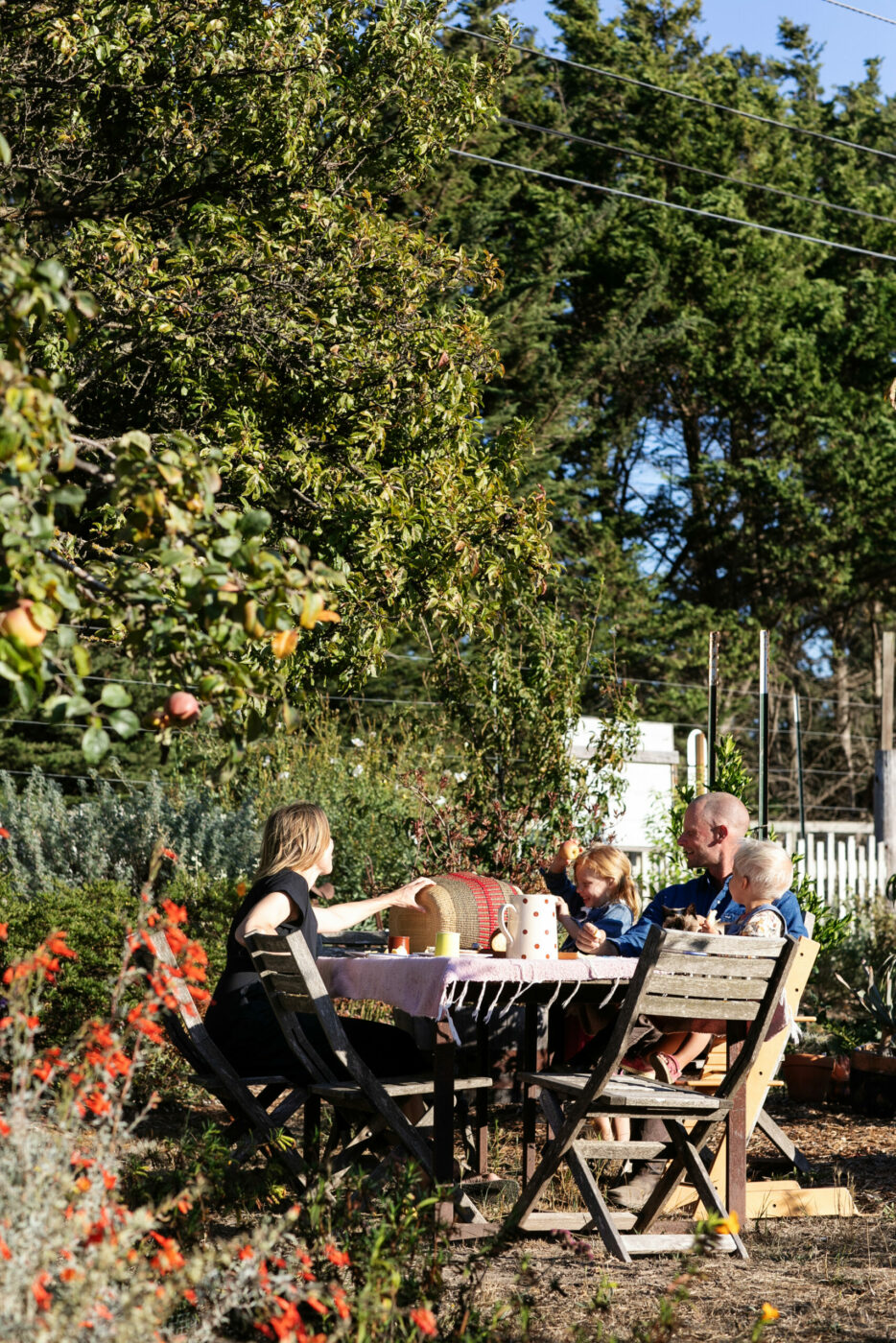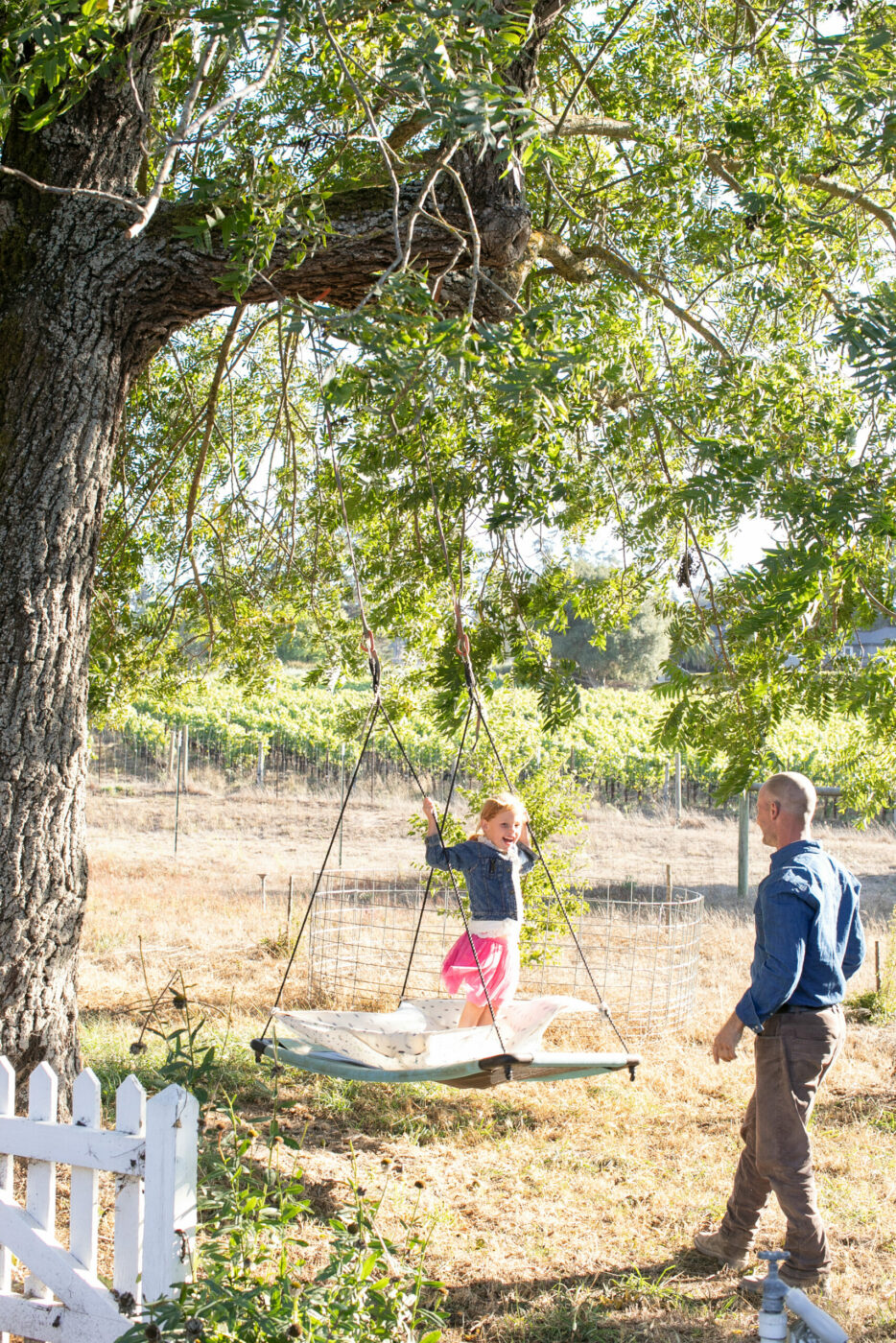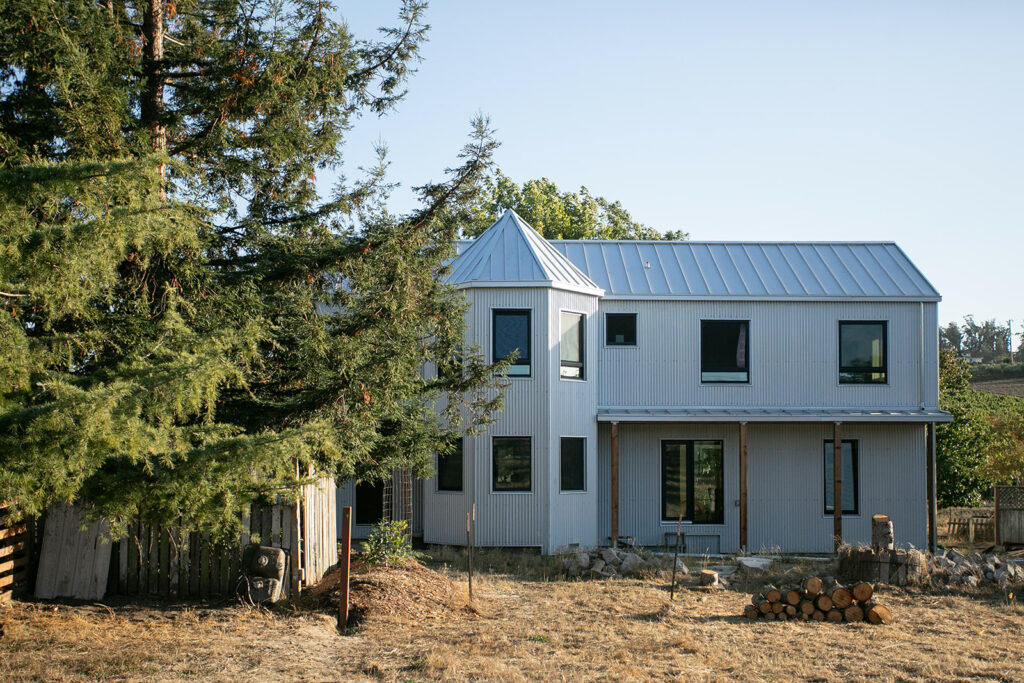When Jason and Kristin Nichols first met at the Sonoma Mountain Zen Center in 2017, they made group dinners together from scratch and washed dishes by hand. And while they worked side by side helping to keep flames from the Nuns Fire from destroying the center, they discovered they shared more than a spiritual path. Seven months later they were married.
Their origin story as a couple was the precursor to a handmade family life, where laundry is hung to dry in the breeze, weekends are spent on DIY projects, and after supper, the sounds of a piano and singing fill the house instead of television.
The pair live on a compact homestead south of Sebastopol they call Windhorse Orchard, with 50 fruit trees, a big garden in progress, and room for their two kids—Eve, 5, and Ryo, 2—to get dirty the old-fashioned way by splashing in a tub with a garden hose or digging in a sandbox their dad made with scrap lumber from their many home improvement projects.
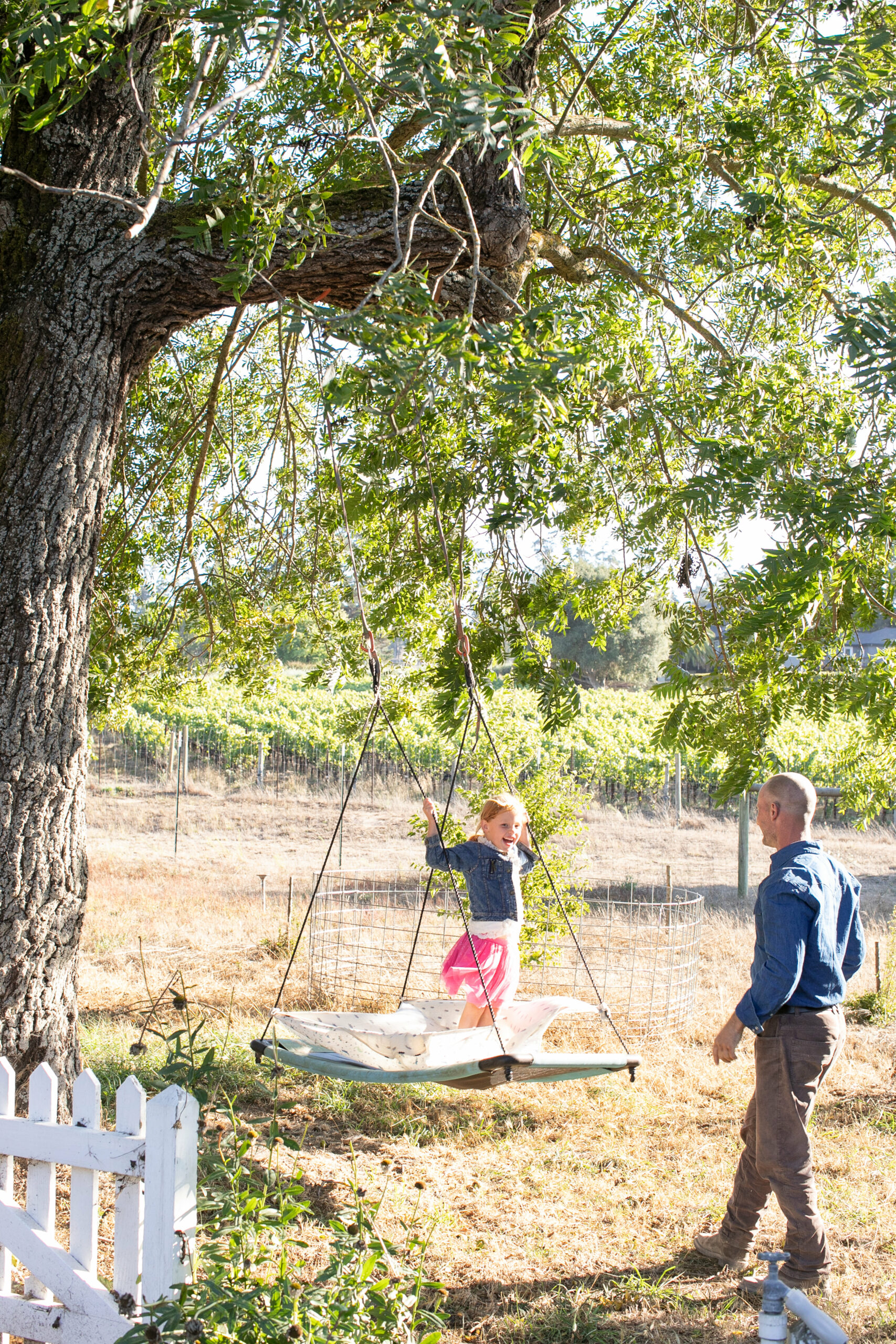
On the surface it looks like a simple life, free of the clutter and gadgetry that bedevil so many young families. But for some five years the Nicholses have been working meticulously to live as sustainably as possible, taking their commitment well beyond many of Sonoma County’s more eco-conscious households. They’ve made their 1980s home ultra-energy- and water-efficient and outfitted it with fixtures and common household items made without toxic materials or processes that may off-gas and pollute their inside air; it’s no easy task since few such products are available. But what is out there, they found.
The Nicholses are committed to creating one of the most sustainable homes anywhere and are well on their way toward becoming the first household to meet two of the most rigorous green building standards in the world. They are close to receiving certification through the Passive House Institute, which focuses on ultra-low energy use and indoor air quality through air tightness, thermal insulation, and mechanical ventilation.
At the same time, they have completed the work and are now spending the next year tracking and documenting the data needed to prove they meet the high demands of the Living Building Challenge. Administered by the International Living Future Institute, which promotes a way of building that is entirely regenerative, the challenge sets standards and goals in seven lifestyle areas. They include place, water, energy, health and happiness, materials, equity, and beauty.
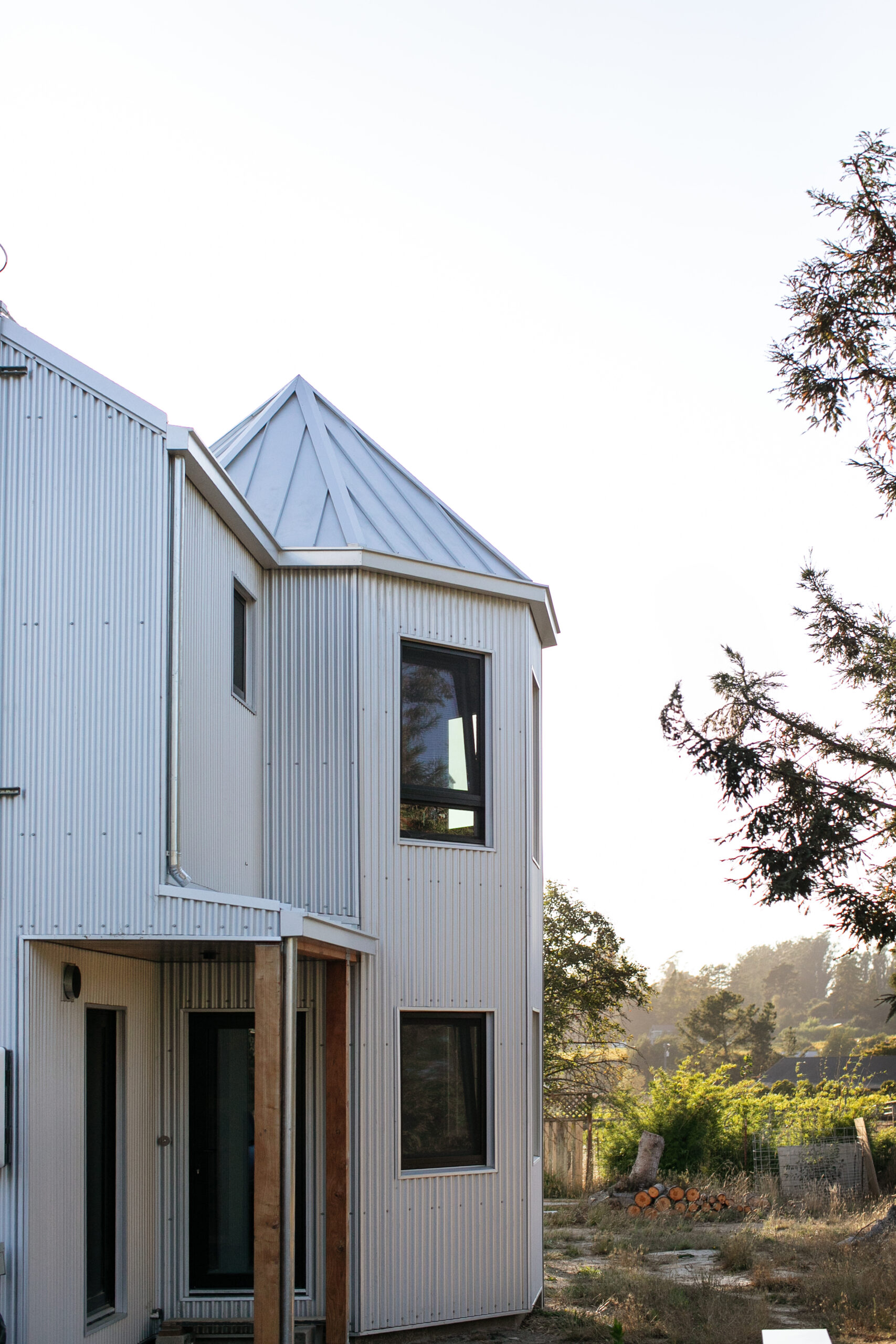
Geof Syphers of Sonoma Clean Power, which provided information, support, and some rebates to help the couple reach their goals, said the Living Building Challenge is a near miraculous bar to reach.
“I made an attempt to build one of those projects 20 years ago and couldn’t finish it. There just weren’t enough compliant materials available in the United States to complete the project,” said Syphers, who used to build passive homes himself. “It’s exciting to see the Nichols (family) achieve that extraordinary challenge.”
A designer of ecological landscapes that emphasize native plants, organic food crops, low water use, and plants that provide habitat for birds, bees, and other wildlife, Jason has been interested in sustainable housing since 2007 when he first saw college students from across the country build 400-square-foot homes constructed of sustainable components on the Washington, D.C., Mall. He started reaching out to people in the movement when he relocated to California from his native New York two years later and developed a dream of one day building a passive home himself.
After years studying the behavioral sciences and political philosophy to better understand human behavior, he says coming to California was a revelation.
“It was only when I started getting in touch with the land and thinking about ecology and other species that I thought, ‘It’s not all about us,’” he says. “When I first got here, I saw the California oaks and the redwoods. I saw the manzanitas and the California lilacs. It’s special. When you’re rooted in a place and say, ‘I love Sonoma County,’ it’s partly by looking around and seeing some of the native topography and flora that makes me feel like I’m not in anywhere USA. I’m in Northern California.”
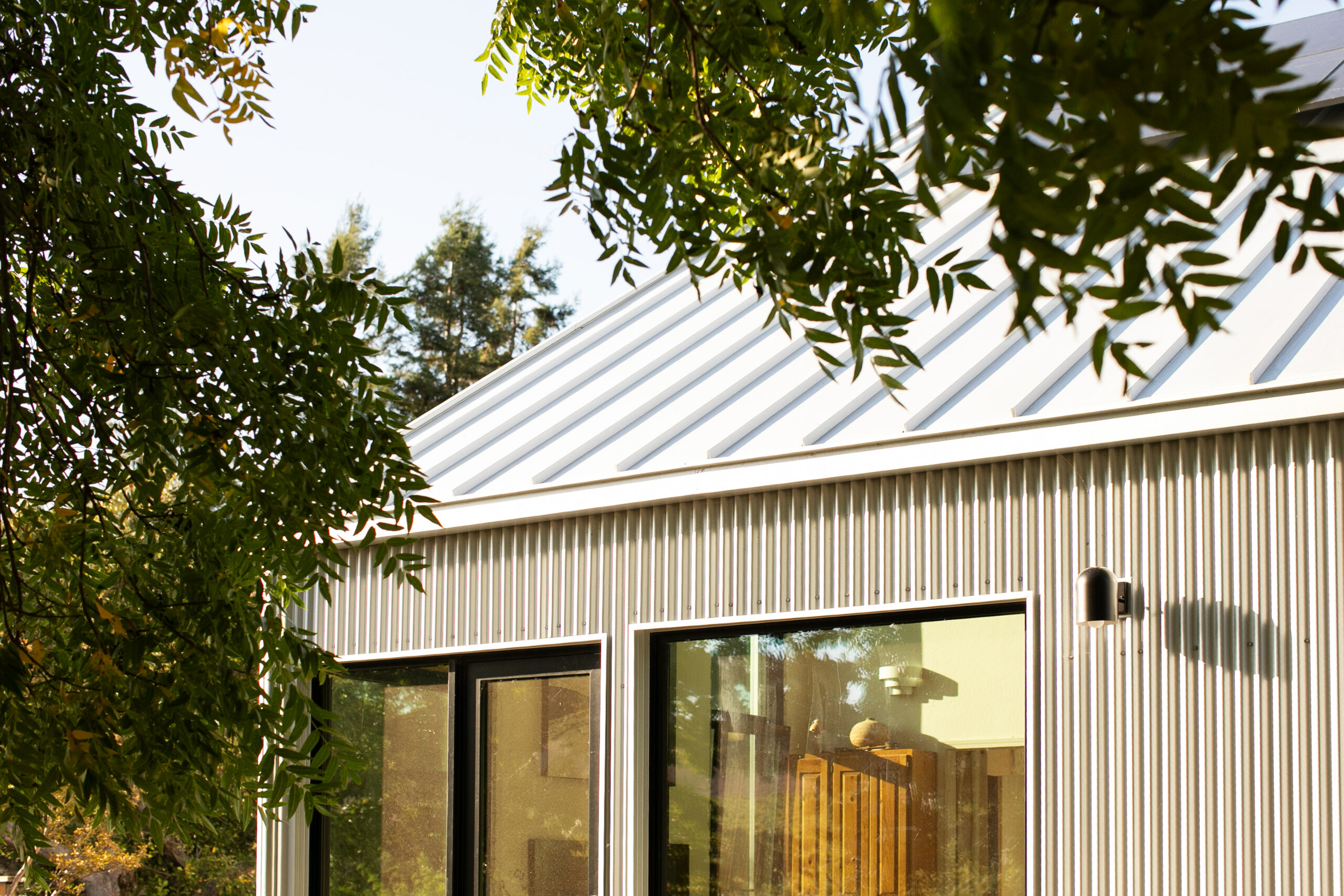
Kristin, an engineer who in her native Germany worked in waste energy—burning waste into useable household energy, a common practice in Europe—easily took to his vision. Concerned about the effects of climate change and environmental degradation, they set out to find the right house to start a family that they could renovate and restore to “the highest and most holistic ecological standards possible.”
After rejecting some 50 properties, they settled on a two-story, 2,300-square-foot home on 3 ½ acres of sandy loam soil. It was bigger than they wanted but had a well and septic system and enough land to accommodate their lofty goal of creating “one of the most environmentally friendly homes and landscapes in America.”
They decided it would be more sustainable to find an older house that needed renovation rather than building a new one. Working largely within the existing footprint—including an octagonal turret reflecting 1980s aspirational architecture—they set about making their own version of a dream home for the 21st century, with Kristin, who is now working toward her architect’s license, overseeing much of the design.
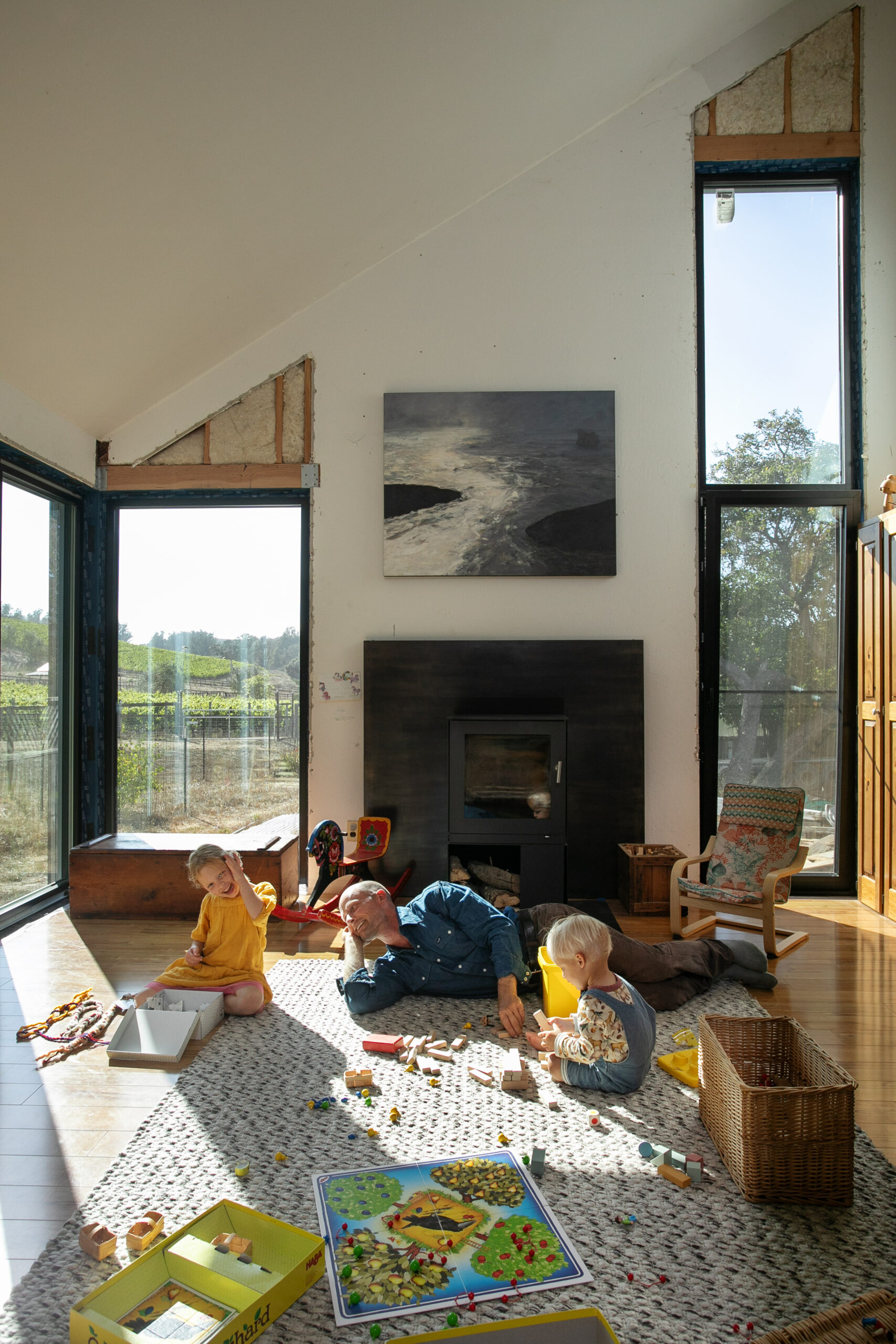
Solar panels weren’t enough. In their effort to reach a Net Zero carbon footprint and produce more energy than they use, they made the house as airtight as possible so it would require minimal heating and cooling. That meant new triple-pane windows and insulated doors. Non-toxic and compostable sheep’s wool insulation wraps the house snug.
They replaced the old siding and roof with Zincalume Plus, made with a high percentage of non-toxic recycled materials that resists fire and termites. They built new decks using reclaimed certified sustainably harvested wood. A new greywater system recaptures water for the landscape and a vacuum-flush toilet sips only a pint of water.
Their green ethos extends to every aspect of life at Windhorse Orchard. They buy dry goods in bulk from Oliver’s to avoid packaging waste; a 50-pound bag of oatmeal will last six months. They refill containers of soap and cleaning products at Sebastopol’s Homebody Refill. Diapering for the Nicholses is old-school, using cotton nappies washed at home through the sanitation cycle in their ultra-energy-efficient Miele washing machine. Kristin buys clothing second hand or from makers that use natural, organic fibers.
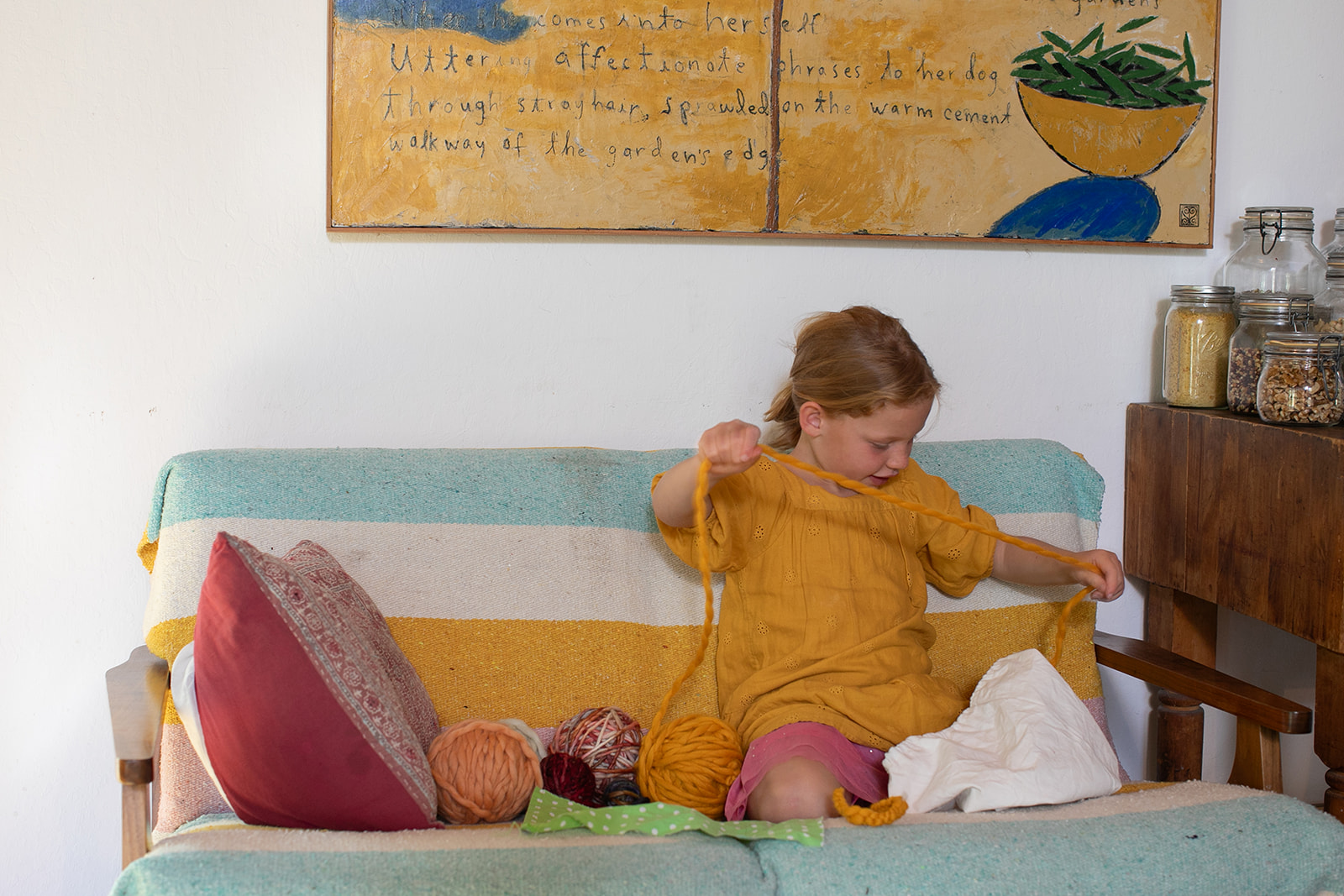
Much of the interior of the home awaits remodeling as time and budget permits. But they did replace the old gas stove with induction and upgraded the 30-year-old refrigerator with an energy-efficient model. Leftover construction lumber and scraps will be used to make raised beds for a food forest garden from which they will harvest much of their own fresh produce.
They track their air quality—part of meeting the Living Building Challenge standards—with an Awair Element sensor that lets them know when the carbon dioxide and VOC levels reach a point where they should open the windows.
While their building budget wasn’t done on a shoestring, the Nicholses believe the economics of paying 10-30% more for some materials balance out in energy savings (up to 90% on typical buildings) and longevity. The siding and roof potentially could last the lifetime of their children. Sonoma Clean Power helped them locate rebates to pay for things like an energy-efficient heat pump and water heater, electrical panel upgrades, and a home EV charger.
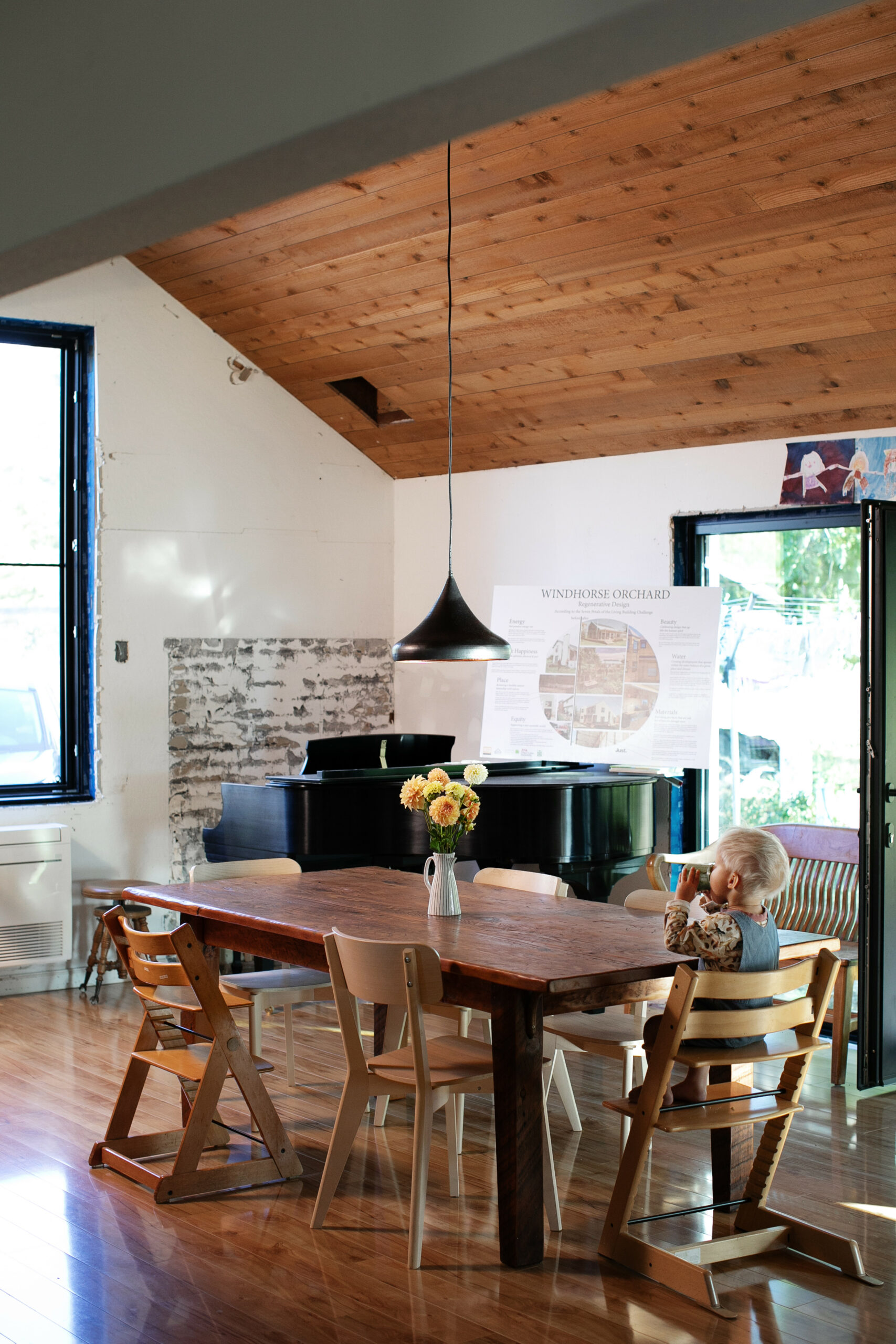
Kristin says it all makes for a comfortable environment inside and out in all seasons. In winter, little additional heat is needed and socks are sufficient to keep toes warm on the floor—even without radiant heat.
“It’s very beautiful to live more closely connected to the elements,” says Kristin. “It’s been lots of fun to harvest the sun’s power, run our equipment, and charge batteries when we have free energy coming in,” says Kristin. By adding bigger windows and cutting away eaves, they now can gaze up into the old walnut trees on the other side of the super-insulated glass and still feel part of nature.
The Nicholses see themselves as influencers. Not the social media kind—although they do maintain an active website with videos sharing their story and helpful information. But within their community, they say, they are trying to model and teach others how to contribute to the planet’s health—and their own health—by living lighter and more conscientiously. When Kristin receives her architect’s license, the couple plans to specialize in designing highly sustainable homes and landscapes like their own. They make their home available for open house tours, with the next on Nov. 9 in conjunction with International Passive House Open Days.

“If everybody would build the way we do or put the same level of attention to whatever they do, there wouldn’t be climate change,” Kristin says. “There wouldn’t be social injustice and there wouldn’t be threats to other species on this planet. Proving to ourselves that it is possible to reinvent the way we do things and make them regenerative has been an extreme source of hope. That’s what I want to give to my children.”
Tour the Home
Passive House Open Days / 10 a.m. & noon, Nov. 9. Register to visit at passivehousecal.org/open-passive-house-days



